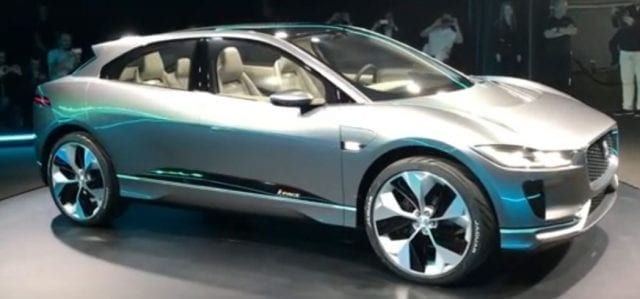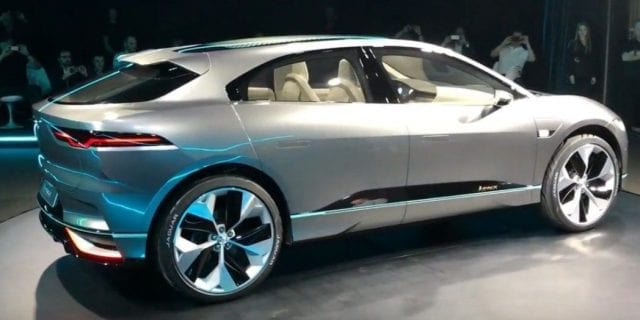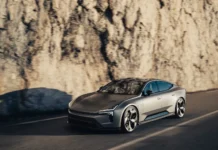British luxury brand Jaguar is preparing cars for the new era – the era of electric vehicles. The I-Pace concept that was revealed at the Los Angeles motor show, to the press at least, is a sure indicator that the Jag is ready for an all-electric competition and rivalry against companies such as Tesla. It is also important to say that other brands will soon enough offer new models with this type of propulsion. The Jaguar took this very seriously and the concept shown in LA can hardly be called concept because it pretty much looks production-ready right now. The I-Pace is advertised as an electric performance SUV that combines a supercar silhouette with sports car power figures and five-seater SUV practicality.
The concept in depth
Well, we shall start from what powers it. The 90 kWh liquid cooled lithium-ion battery pack is what is pretty much the prime feature of this British concept, and Jag claims that it allows the I-Pace to have a range of up to 500 km. Each axle of the car has its own electric motor with a power output of 147 kW/350 Nm, which combined makes a total of 294 kW and 700 Nm. All of this power is hooked up to a single speed transmission that sends the power to all four corners of the car allowing the I-Pace a sprint from 0-60 MPH (0-96 km/h) in “around 4.0 seconds”. This still needs to be confirmed, but if this is true, then we are getting a vehicle that is quicker than the Tesla Model X 90D (has the same 90 kWh battery pack) which is its main competitor. If you add Model X P90D to the mix Jaguar falls short by far in terms of acceleration.

Many believe that the I-Pace is just an electric version of the recently launched F-Pace SUV, just riding on the all-new architecture and smaller in size than its petrol-powered older brother. They do have some differences in dimensions, meaning that the I-pace is shorter, narrower and lower than the F-Pace, but its wheelbase is much longer allowing the I-Pace to have superior rear passenger legroom. Despite the sporty design and sportback roof line it still has a luggage capacity of 530 L which is admirable.
Jaguar I-Pace design
The I-Pace looks just like it should – like a true Jaguar, and it has accomplished that by borrowing elements from other models that this company has. The front hints a slight inspiration by the C-X75 hybrid supercar if take a look at the hood and the hood scoop. Other segments like the roofline bring similarities to the F-Pace feel while the back has hints of F-Type in the tail-lights and XE and XF sedans cues are incorporated into the wide and flattened look at the front. The car has been made to be as efficient as possible, and that is why its design predicted a need for hidden door handles that slide out when activated, optimized side skirts than channel air more efficiently around the wheels with the main purpose of reducing drag coefficient. While we are on the subject of design and wheels, it is good to mention that the concept received unique 23-inch “Nighthawk” rims finished in Technical Grey with Gloss Black inserts in a diamond-turned finish that have 265/35/R23 tires with unique pattern wrapped around them.

Inside the car, everything is driver oriented using the latest “flight deck” design. A 12-inch touchscreen infotainment system is the primary interface, while a 5.5-inch secondary touchscreen display is positioned beneath it, between two aluminum rotary dials for the climate controls with their own LCD units. The cabin also hosts a 12-inch fully-digital instrument cluster and color head-up display tucked behind a new three-spoke steering wheel that features multi-function capacitive switches that also have a “micro-click” function when pressed. Another option that comes pretty much standard, and is now a must, is a Wi-Fi hotspot.
The mechanicals
The I-Pace concept, besides the outside design, has the mechanical parts that are similar to the F-Type and F-Pace such as a double-wishbone front suspension set-up, the same Integral Link rear suspension which can be found featured in the XE, XF, and F-Pace. The concept’s sporty ride and handling characteristics draw roots from its suspension systems and low center of gravity according to Jaguar. The battery is magnificent, and it offers a relatively time-efficient charging process (80% charge taking 90 min and 100% taking just over two hours using 50 kWh DC charging). The battery itself is housed in the lightweight aluminum case and is conceived as an integral part of the I-Pace’s body structure.
The I-Pace is still in its concept form, but according to Jaguar, the production version will be revealed in late 2017 before hitting the road sometime in 2018. Director of design at Jaguar, Mr. Ian Callum said that “The I-Pace concept is a radical departure for electric vehicles. It represents the next-generation of battery electric vehicle design. It’s a dramatic, future-facing design – the product of authentic Jaguar DNA matched with beautiful, premium details and British craftsmanship”, and added “This isn’t just a concept. It is a preview of a five-seat production car that will be on the road in 2018. This will be Jaguar’s first-ever battery-powered electric vehicle and opens a new chapter in the history of our legendary brand”.








